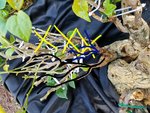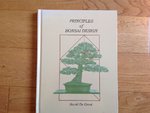SU2
Omono
Yeah I noted that upon seeing it, have had it hammered-into my brain that I shouldn't be following that exactly when doing flowering deciduous broadleafs *but* IMO there's so much carryover (and IYO obviously ;D ) I like to think of my approach to this specimen as similar in how I want the branch-structure to go in terms of branch-flow / branch-lines, I just want to 'squish it' so it's more compact & hugs the trunk tighter than is desired for most other trees (almost the stereotypical "bush of flowers on a bougie stump", only I want it to look good defoliated instead of just being a mess LOL)My example is of a pine, but pretty much all trees make pads, and the general concept is the same. (Some styles, like broom style, don’t make pads).
But if you want to make effective pads, the layering approach is the way to go.
That's, that's brilliant!! Although I didn't know that "they all will, eventually", I had kinda just thought that as the branch grew, newer buds from lower would 'step up' and it'd be a perpetual process, not something where a branch has a lifespan as you describe (is that always the case? That just doesn't sound right, I mean when I look at trees like the one I'll post here, it's hard to imagine they're chopping branches off it seems they're just developed indefinitely:One more thing...
When building pads, occasionally put in a “top branch”. That’s an interior branch that does not go left or right, but runs in the same direction as the underlying primary branch. This can be trained to lay directly above the primary branch. It will provide height to the pad, and when the time comes to cut back the primary branch when it grows too long (as they all will, eventually), you have a ready-made branch to take its place.

I guess I always thought the furthest-back branches eventually became tips as the thing grew-out, do you mean that when caring for something like ^ that you would actually be removing primaries, or did you mean some degree of tertiary-branching, something halfway-back from the canopy-edge to the primaries' collars?
PS- this is my favorite 'tree' of all time, anyway it gives a great idea of the compact-ness I'm aiming for, really want to go as dense&tight as possible:



